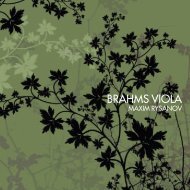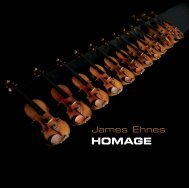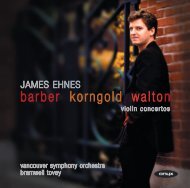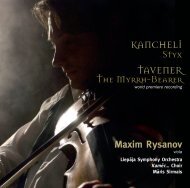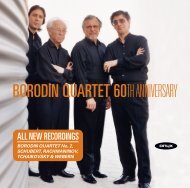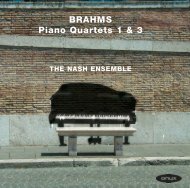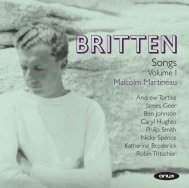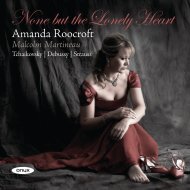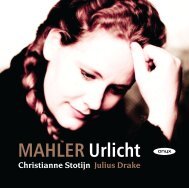TAN DUN HAYASHI TAKEMITSU - Onyx Classics
TAN DUN HAYASHI TAKEMITSU - Onyx Classics
TAN DUN HAYASHI TAKEMITSU - Onyx Classics
- No tags were found...
Create successful ePaper yourself
Turn your PDF publications into a flip-book with our unique Google optimized e-Paper software.
<strong>TAN</strong> <strong>DUN</strong>PIPA CONCERTOworld premiere recording<strong>HAYASHI</strong>VIOLA CONCERTO<strong>TAKEMITSU</strong>NOSTALGHIAWU MAN pipaYURI BASHMETviolin & violaMOSCOW SOLOISTS
<strong>TAN</strong> <strong>DUN</strong> (1957–)Concerto for String Orchestra and Pipa (1999)world premiere recording - first performance at the Pacific MusicFestival, Sapporo, Japan, July 19991 Andante molto 3.542 Allegro 6.363 Adagio 4.444 Allegro vivace 5.07TORU <strong>TAKEMITSU</strong> (1930-1996)5 Nostalghia for solo violin and string orchestra (1987) 16.13in memoriam Andrey TarkovskyThree Film Scores for Strings6 Music of Training and Rest José Torres (1959) 4.407 Funeral Music Black Rain (1989) 4.098 Waltz Face of Another (1966) 2.18HIKARU <strong>HAYASHI</strong> (1931-)Concerto-elegia for viola and strings (1995)commissioned by Mito Chamber Orchestra, dedicated to principalviolist Nobuko Imai. First performance in June 19959 I 17.3510 II 12.43Wu Man pipa (1–4)Yuri Bashmet violin (5), viola (9, 10)Total Time 78.02Moscow SoloistsYuri Bashmet director (1–4, 6–8)Roman Balashov director (5, 9, 10)
The conceptual and multifaceted Chinese composer Tan Dun has made an indelible mark on theworld’s music scene with a creative repertoire that spans the boundaries of classical, multimedia,Eastern and Western musical traditions.Most famous for his Oscar-winning original score for Ang Lee’s film, Crouching Tiger, Hidden Dragon,Tan Dun’s primary interest lies in creating new works and programmes that reach a new and diverseaudience, and those that break the boundaries between the classical and non-classical, East andWest, avant-garde and indigenous art forms.Based in New York, Tan Dun was born in Hunan, China. Having served as a rice-planter and performerwith the Peking opera during the Cultural Revolution, he later studied at Beijing’s Central Conservatory.There he encountered Western classical music and in particular a range of 20th-century repertoirepreviously suppressed in China. Tan Dun soon became the leading composer of the “New Wave” ofcontemporary music in China, which embraced a new cultural pluralism in the arts that began todevelop in the early 1980s. He later completed a doctorate in composition at Columbia University,New York where he discovered the experimentalists Edgard Varèse, Philip Glass and Steve Reich.Central to Tan Dun’s body of work are several distinct themes that reflect his personal ideals:“organic music”, consisting of works which incorporate elements from the natural world, such as theWater Concerto for Water, Percussion and Orchestra; “multimedia with orchestra”, including thesymbolic work The Map: Concerto for Cello, Video and Orchestra; and echoes of shamanistic ritualas seen in The Gate and Ghost Opera. This work for pipa and string quartet is one of his mostpopular, and the present Pipa Concerto is an adaptation of some of its music into more conventionalconcerto form. The inspiration for this chamber composition was the 4000-year-old Chinesetradition at Taoist funerals in which shamans communicate with spirits past and future, creating adialogue with nature and the human soul.The Concerto is not simply a re-arrangement of the string quartet part for string orchestra. Theearlier composition was in five movements and the players perform on various other instrumentsincluding gongs and water bowls, tam-tam, Tibetan bells, and paper. They also vocalize lines fromShakespeare and Chinese folk song. As befits its title it is a clearly theatrical piece of chamber music.The Concerto, on the other hand, is cast in four movements, the players playing only their owninstruments, but also contributing stomps, yips, yells sighs and hand-slaps, sometimes in imitationof Eastern instruments.
of nostalgia — that of the Russian for his homeland. His visual style is poetic, full of images, slowand thoughtful in pace. Takemitsu’s tribute reflects that quiet elegiac mood: harmonics and slidingnotes hint at traditional Japanese music and it is the shifting harmonic texture beneath the soloistthat gives the work its special flavour.Nostalghia, a work reminiscing about a film director, leads appropriately to some of Takemitsu’sactual film music: José Torres (1959) is a documentary about boxing filmed in the gyms of New York,evoking bluesy harmonies and melodic turns that are a far cry from what we normally expect ofTakemitsu. “Music of Training and Rest” is by turns vigorous (a strong bass riff and a hint of “It ain’tnecessarily so”) and warmly lyrical. Black Rain (1989) tells of the effects of the Hiroshima bomb’sradiation on a young woman who had walked through the ruins of the city. The film dealt with theguilt that many Japanese felt for the role that their country had played in bringing such destructionto the homeland. The cue “Funeral Music” sustains a sombre mood of poignancy and loss in itspulsing rhythms, arching and falling melody, and gentle dissonances. Face of Another (1966) alsodeals with horrible facial injuries that the leading character suffers in an industrial accident. Fearingthe loss of his identity, he undertakes to obtain a new face through plastic surgery. With it comes anew personality and the film turns to the horror genre. Takemitsu’s music here often draws ontraditional elements, such as this waltz evoking a sense of the loss of the “normality” of thecharacter’s life before the accident.Hikaru Hayashi (1931–) is a prolific composer active in virtually all genres. He studied at the TokyoUniversity of Arts and, since the early 1950s, has produced a large body of work, including operas onShakespearean subjects, Kafka’s Metamorphosis, Chekhov’s Three Sisters, and several orchestralscores (of which this viola concerto is one of the most recent). In Little Landscapes of Hiroshima, astark choral work, he deals with the aftermath of the atomic bombing of the city. He is also creditedwith over 80 film scores.The Concerto “Elegia” for Viola and Strings (1995) is the most Western-sounding of the works on thisdisc and a major addition to the viola repertory. Stylistically Hayashi, while very much his own man,seems to draw inspiration from the Eastern European and Russian masters of the interwar years. Thefirst movement opens quietly with the viola ruminating alone, alternating with interjections frompizzicato strings. Momentum and volume gradually build to a strongly rhythmic, Bartók-like theme,and then soloist and orchestra combine for the first time with the movement’s impassioned maintheme, based around the interval of a falling minor third. After much interplay the movement seems
to have be drawing to a conclusion but suddenly new energy is found in the form of two otherthemes, one based on a four-note semiquaver motif reminiscent of Janáček, the other a more lyricaldiatonic theme for the soloist. The movement concludes with a return to the “falling third” themeexploiting the full range of the instrument with intricate harmonics and double stopping.The hypnotic second movement is based around the contrast between a pendulum-like accompanimentfigure in the orchestra and the oily chromatic cantilena starting in the solo viola. The viola introducesthe second theme which again utilises the falling minor third, the parallel octaves lending a distinctivelyEastern flavour. The material is developed with colour, dramatic flair and rather in the manner of aconcerto grosso, with solo opportunities for other instruments. The viola takes up the accompanimentfigure almost in parody with multiple double-stopping and pizzicati, before reverting to its moreorthodox elegiac presentation and the work dies away with a nostalgic reminder of the Eastern theme.ONYX 2008Executive Producer: Paul MoseleyProducer, editing and mastering: Philipp Nedel, B-Sharp Media SolutionsEngineer: Michael BrammannRecording location: Schloss Neuhardenberg, Berlin, Germany, 26–28 September 2007Photos: Yuri Jouludev (Yuri Bashmet with Moscow Soloists); Sasha Gusov (Yuri Bashmet);Design and montage: Paul Mitchell for White Label Productions Ltd.Liu Junqi (Wu Man)Novatek – General sponsor of the Moscow SoloistsBosco di Ciliegi – Sponsor of the Moscow SoloistsWith many thanks to Roman Balashov and Philipp NedelSpecial thanks to Schloss Neuhardenberg forproviding the venue and their kind hospitality
Through his virtuosity and strength of personality Yuri Bashmet is well known as a viola virtuosoand a champion of new music. He is Principal Conductor of the Symphony Orchestra of New Russia,and is the founder and director of the Moscow Soloists. As a soloist he has appeared with all theworld’s great orchestras, including the Berlin and Vienna Philharmonics, Royal ConcertgebouwOrchestra, Boston, Chicago and Montreal Symphony Orchestras, New York Philharmonic, LondonPhilharmonic, and the London Symphony Orchestra. He has inspired many composers to write forhim, and enjoyed strong collaborations with Sofia Gubaidulina and Alfred Schnittke in particular. Mr.Bashmet is also active as a recording artist, and his recording of Gubaidulina’s Viola Concerto forDeutsche Grammophon (DG) earned him a Grammy nomination. Additional DG recordings includeMozart’s Sinfonia Concertante featuring Anne-Sophie Mutter, and Bartók’s Viola Concerto with theBerliner Philharmoniker and Pierre Boulez. For ONYX he has embarked on a series of recordings withThe Moscow Soloists and also recently completed a solo Encores disc with pianist Mikhail Muntian.The pipa is a lute-like instrument with a history of more than two thousand years. During the Qin andHan Dynasties (221 B.C.-220 A.D.), instruments with long, straight-necks and round resonators withsnake skin or wooden soundboards were played with a forward and backward plucking motion thatsounded like “pi” and “pa” — hence the name “pipa”. During the Tang dynasty, by way of Central Asia,the introduction of a crooked neck lute with a pear-shaped body contributed to the pipa's evolution.Today's instrument consists of twenty-six frets and six ledges arranged as stops and its four strings aretuned respectively to A-D-E-A. The pipa's many left and right hand fingering techniques, rich tonalqualities and resonant timbre give its music a unique expressiveness and beauty.Born in Hangzhou, China, pipa player Wu Man studied at the Central Conservatory of Music inBeijing, where she became the first recipient of a master’s degree in pipa. Trained in the PudongSchool of pipa playing, Ms. Wu is recognized as a champion of traditional repertoire as well as aleading interpreter of contemporary pipa music. She collaborates with some of today’s mostdistinguished musicians and conductors, including David Zinman, Cho-Liang Lin, ChristophEschenbach, and Esa-Pekka Salonen. A frequent participant in Yo-Yo Ma’s Silk Road Project, Ms. Wurecently performed with the group at Carnegie Hall, and also performs and records with the KronosQuartet. Ms. Wu performs as soloist with many of the world’s major orchestras, including the BostonSymphony Orchestra, the Los Angeles Philharmonic, the New York Philharmonic, and the NDRSymphony Orchestra, Hamburg, and the Stuttgart Chamber Orchestra.
One of the world’s most highly acclaimed chamber ensembles, The Moscow Soloists was foundedby Yuri Bashmet in March 1992. Comprised of leading young graduates all under 30 from the MoscowConservatory, the orchestra made its debut in May 1992, and two days later made a highly successfulParis debut at the Salle Pleyel. Since that time, the Moscow Soloists have performed in many otherprestigious venues, including Carnegie Hall in New York, the Royal Albert Hall and the Barbican Centrein London, the Theatre des Champs Elysees in Paris, the Philharmonie in Berlin, the Concertgebouw inAmsterdam, and Suntory Hall in Tokyo.Additionally, tours have taken the orchestra to the USA, Puerto Rico, Australia, New Zealand, HongKong, Taiwan, Israel, Greece and Turkey. Its festival appearances have included concerts at the BBCProms, the Evian Festival, the Montreux Music Festival, the Sydney Festival and the annual DecemberNights Festival in Moscow. In 2007 the Soloists celebrated their 15th anniversary worldwide withmajor tours of the USA and Russia, including the repertoire from this CD.The Moscow Soloists have worked with such celebrated soloists as Sviatoslav Richter, Gidon Kremer,Mstislav Rostropovich, Maxim Vengerov, Barbara Hendricks, Lynn Harrell and James Galway. Theirrecordings include the Schnittke Triple Concerto with Kremer, Rostropovich and Bashmet himself(EMI), works by Brahms and Shostakovich (Sony), and their three ONYX recordings, the first two ofwhich were nominated for Grammy Awards.Moscow SoloistsYuri Bashmet (director)Violins IViolins IIStepan Yakovich (leader)Andrei PoskrobkoMikhail AshurovIrina ShevliakovaOlga KolgatinaSergey LomovskyLeonid FerentsMaxim GurevichGerman BeshulyaViolasCellosDouble BassVitaly AstakhovNina MatcharadzeRoman BalashovAlexander IlatovskyAlexei NaidenovAlexei TolstovNikolay SolonovichMaxim Khlopiev
Also available on ONYX from Moscow Soloists/Yuri Bashmet:SHOSTAKOVICH/SVIRIDOV/VAINBERG: CHAMBER SYMPHONIESONYX 4007Grammy Award Nomination 2006STRAVINSKY APOLLO, CONCERTO IN D/ PROKOFIEV: VISIONS FUGITIVESONYX 4017Grammy Award Nomination 2007***** BBC Music Magazine10/10 <strong>Classics</strong>Today.com ‘These performances are outstanding’
ONYX 4027 www.onyxclassics.com



